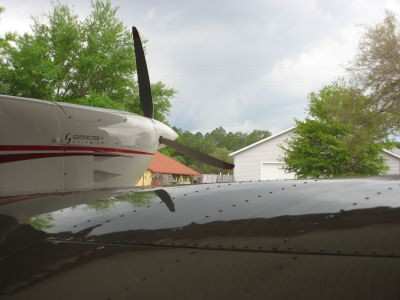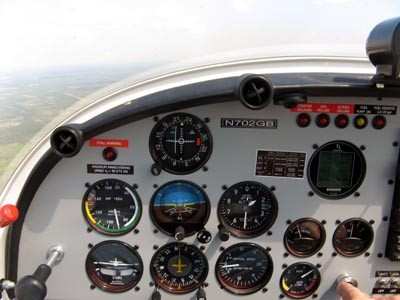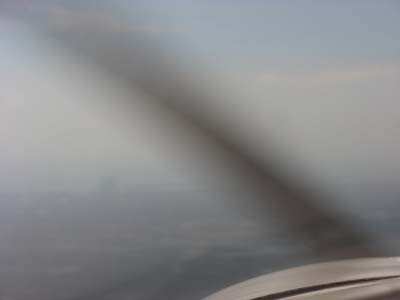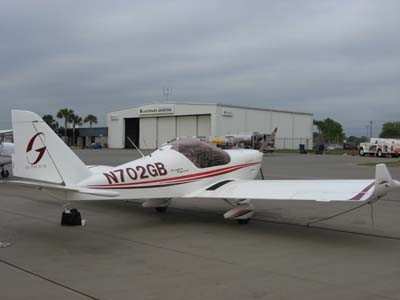Heading Back Home, And Dealing With The Ides Of March
by ANN Managing Editor Rob Finfrock
The skies looked gloomy overhead as I sat in the small pilots
lounge Sunday morning at Charlotte County Regional Airport in Punta
Gorda, FL. According to weather information obtained through AOPA's
Flight Planner, things looked even gloomier to the north, right
over the area where Jim and I planned to be flying through within
the next couple hours.

The six-hour forecast showed low-ish clouds and rain showers
were expected to dominate the route up to Lakeland, and over
towards Crystal Lake (CGC) where we planned to stop.
From that point, the plan was to either turn northeast towards
Green Cove Springs, or -- if time and weather allowed -- take a
short side jaunt over the Gulf to Cedar Key (CDK), where the
combination of a picturesque setting and the promise of good
seafood were beckoning.
A New Sensation... And Another Lesson
Conditions this Sunday morning, March 30, were a marked
difference from the day before. Bright sun, high puffy clouds and
muggy temperatures were the name of the game on Saturday, and
promised fine conditions to get some additional training in. I'd
met Jim at PGD that afternoon, after he'd wrapped up his last
flight lesson for the day. A number of other planes were overhead,
also taking advantage of the beautiful, if warm, weather, and I
looked forward to joining them.

I also sensed my solo was looming... and there was no particular
reason why we had to wait to return to Palatka to get that out of
the way. I felt ready, and eager to get it out of the way after Jim
and I did some more dual work.
But, alas, it wasn't meant to be that way. The first sign of
trouble came during my preflight, when I noticed my necklace -- a
small gold pendant set on a thin chain, that my good friend Jen had
given me a few years back -- was missing. I'd apparently forgotten
to put it on that morning, in my haste to meet Jim at the
airport.
This is where superstition kicked in. Jen had given me this
necklace about four years ago. The inscription on the pendant --
"Pray for us who fly" -- referred at the time to my ongoing flight
training efforts, and I'd made it a point to wear it on every
lesson since then; following my cancer diagnosis in early 2006,
though, I'd taken to wearing it every day.
I'd be lying if I said I brushed off its absence as not a big
deal. I even told Jim that it gave me some pause about the lesson.
Still, I didn't feel it should be a reason not to fly -- the plane
was in perfect health, we had a full tank of gas, and beautiful
days aren't a resource to be ignored.
I shoved my missing necklace from my mind as we taxied out for
departure on runway 3, and held for landing traffic. Immediately
after we called our takeoff roll for closed traffic, a new voice
joined the cacophony on the CTAF -- a Skybus pilot, calling 10
miles out to land at PGD from the southeast.
Of course, the Airbus wasn't a factor for us as we took off...
but the fact the pilot planned to land on 33 -- the runway nearest
the terminal, of course -- meant our left traffic pattern for 21
would be impacted.
My takeoff was passable, but I unintentionally turned a
shallower crosswind leg than I'd meant to. A combination of factors
was at work here -- an unfamiliar airport, lots of other planes in
the pattern and an overly-frantic search on my part for sight of a
large orange airliner careening towards us. In simple terms... that
approaching Airbus had moved my cheese, and left me
discombobulated.
Jim pointed out my shallow turn -- the proper heading was 300,
mine was closer to 320 -- and noted I was flying us out of the
traffic pattern. Fortunately, there was no other traffic behind us,
so Jim suggested I turn back onto the proper heading and fly a wide
pattern, to keep the approach path of the airliner inside our
track. (In hindsight, I should have taken a picture of one of the
last Skybus planes to ever land in Punta Gorda, before the airline
folded six days later. It's a bittersweet memory.)

By the time we were at midfield on the downwind, though, it
became clear we'd conflict with the Airbus on our base leg. The
plane ahead of us in the pattern saw this, too, and decided not to
play chicken with an A319. I followed his lead, and announced we'd
also exit the pattern until the airliner was on the
ground.
 "Let's fly over the bay,
and I'll show you what Rotonda looks like from above," Jim told me,
referring to the community laid out in a concentric circular
pattern (shown at right, thanks to Google Maps) across the bay from
PGD. "It's pretty neat."
"Let's fly over the bay,
and I'll show you what Rotonda looks like from above," Jim told me,
referring to the community laid out in a concentric circular
pattern (shown at right, thanks to Google Maps) across the bay from
PGD. "It's pretty neat."
As I banked us over the water, heading west, Jim consulted his
checklist for maneuvers we still needed to cover. Since we'd made
considerable progress over the last two days -- getting takeoffs
and landings down had done wonders for my learning curve -- the
list was short. "Let's practice some accelerated stalls," Jim
said.
I climbed to 3,000 feet, and scanned for nearby traffic. Jim
then took over the controls; before starting the demonstration, I
took the opportunity to take some pictures.
And then... things got weird. As the Gobosh slowed to 60 knots,
I felt my stomach gurgle ever-so-slightly, and I realized I felt
flush. Though it was a warm day, things were fairly comfortable in
the cockpit; the 700S has ample ventilation, not only through two
small sliding panels in the canopy (seen on most like-equipped
LSA) but also via four eyeball vents that run along the instrument
panel combing, right where they're needed the most.
I wasn't sweating... nor did I feel "sick," per se. I'll add
here that I have NEVER gotten airsick, whether flying commercially
or in smaller planes. I had somewhat expected to when I flew
aerobatics for the first time ever, last year... but even those
fears had proven to be unfounded.
Since I wasn't nauseous, I kept quiet... figuring the sensation
would pass. As Jim then performed a cross-controlled stall to the
left, however, my stomach jumped. I still was not queasy... but I
sensed that was the path I was heading towards. What
the...?
"Um, I feel strange," I told Jim, as I instinctively grabbed the
IP to steady myself (a meaningless gesture, of course.)
By that point, Jim had already recovered and brought us to wings
level. "You sick?" I nodded, sort of. "There's a strip near
Rotonda we can land at," he said. "I can have us on the ground in
about five minutes."
I reassured him I wasn't in danger of hurling. "Let's fly level
for a bit," I said. "Can I have the controls?" I thought perhaps
flying the plane myself would help calm my stomach.
 After puttering over
the bay for about five minutes, though -- heading back in the
general direction of PGD -- I realized trying to salvage a lesson
from this would be a lost cause. "Let's head back to Charlotte
County," I told Jim, resigned.
After puttering over
the bay for about five minutes, though -- heading back in the
general direction of PGD -- I realized trying to salvage a lesson
from this would be a lost cause. "Let's head back to Charlotte
County," I told Jim, resigned.
I stayed on the controls for the next two minutes, before
relinquishing the plane to Jim. "If I had to -- if I was
alone -- I think could land safely without a problem," I said. "But
since you're here..."
Back on the ground in Punta Gorda, Jim and I discussed what may
have happened. After landing the evening before, we'd gone out for
dinner... and I'd had a beer. I have a fairly low tolerance for
alcohol (again, ONE beer)... but I hadn't felt hungover at all the
next morning, and besides, our short flight was easily 15 hours
after that.
But I also hadn't drank any water afterwards; all I'd
had since was coffee, and a glass of iced tea at the restaurant at
PGD. Near as I can figure, I was probably dehydrated. By
Sunday morning, I felt great again.
It will always be a mystery, I guess... but there's another
possibility, too. I now double-check to make sure I have my prized
necklace on before leaving to go fly... just in case my mind had
played tricks on me.
Rain, Clouds, Scud... Go Away!
Back to Sunday now. Jim walked into the pilot lounge at around 1
pm, after his last lesson. "Check the weather?" he asked me.
"Things are great around here, but it looks a little darker to the
north."
I had just checked the weather again online. "Ceilings around
5,000 feet, light rain showers but no convective
activity anywhere close from here to Crystal River," I
said. "Though it's looking pretty socked in anywhere east of
there."
Jim nodded. "Well, call Flight Service to make sure, but
assuming they say it's fine let's head to Crystal River and go from
there," he said. "Maybe things will clear up towards the east as we
head to Cedar Key."
Within a minute, Flight Service confirmed the weather was indeed
fine, with only a report of "marginal" VFR conditions closer to
Tampa. Over Orlando, however, things were socked in. "You should be
clear all the way to Crystal River," the briefer told me. "And
there's an airport about every 10 miles if things change" the
briefer reminded me -- another benefit of flying over Florida.

We took off after 2 pm. The first portion of our route
essentially retraced the path we'd taken heading down to PGD on
Friday, so I used the same landmarks. Shortly after we leveled off
at 3,000 feet, the rain started -- light showers, that turned a bit
heavier the closer we got to Lakeland. Still, the overcast cloud
ceiling remained comfortably above us, and visibility was
easily greater than 15 miles; looking off to the west, I could even
see the outline of downtown Tampa, distinct even through the clouds
in the area.
The remainder of our trip to CGC was uneventful. The skies
cleared a bit once we turned northwest past Lakeland, though we
also picked up a sizable easterly breeze. By the time we entered
the pattern at Crystal River, the wind on the ground was blowing at
a steady 15 knots, gusting to 20... but it was also straight down
runway 9. My landing was one of my best yet, a true greaser.
By now it was close to 3:30 pm... and the skies looked
increasingly ominous to the east. After commiserating a bit, Jim
and I opted to stay on the ground in Crystal River for lunch,
rather than heading off for Cedar Key. Instead, we borrowed the FBO
truck to head to Chili's.
One hour later, back at the airport, not much appeared to have
changed. The winds were still blowing on the ground, and it was
still cloudy off to the east. I called FSS for an updated forecast
-- this time, I had to wait over 10 minutes before getting
through to a local briefer, though this was the ONLY time
during my training I had to wait so long.
Once I got through, the briefer didn't paint an optimistic
picture. "Ceilings around 2,000 feet reported east of Ocala, and it
only gets worse the further in you go."
Going around the clouds wasn't an option; the cell extended
north well past Jacksonville, south of Orlando, and all the way to
the Atlantic Coast. A call to Jim Campbell also confirmed what I'd
feared: a very low cloud deck had hung over Haller since early that
morning, and showed no signs of lifting.
Decision time. It looked pretty obvious we weren't going to make
it back to Haller. Still, the path from Crystal River to Ocala
seemed more-or-less clear... and the closer we could get towards
our destination, the better. After fueling up, Jim and I taxied out
for departure. With the wind, it seemed we hardly had any ground
roll at all before we were airborne.
From the moment we climbed past 500 feet, we were in for a bumpy
ride. By definition, light sport aircraft aren't ideal planes to
fly in turbulent conditions, even near their gross weights. Even at
the maximum of 1,320 lbs, the Gobosh has relatively light wing
loading -- the result of all the wing area (including the 700S's
distinctive winglets) added to the Aero AT-3 to slow it down to LSA
standards, and to reduce its stall speed.
We were being tossed around pretty good -- but I didn't
feel sick at all, further reinforcing the opinion I only had myself
to blame for feeling ill the day before (I ruminated on this while
taking a sip from the water bottle I had since started carrying
with me.)
As we drew closer to Ocala, it became clear we wouldn't
make it much farther on this leg. The ceiling had progressively
lowered as we'd flown further from Crystal River, requiring
us to descend to 1,500 feet to maintain adequate
clearance. The clouds looked even lower straight ahead.

"Looks like we're spending the night in Ocala," Jim said. We
consulted the chart, which showed OCF just five miles ahead, easily
within sight once I knew where to look. My landing was decent,
too... especially considering the rather heady crosswind on
final.
That's the thing about strictly day-VFR flying... sometimes,
you simply must concede the victory to the weather gods. I
considered this truism from the ramp at Landmark Aviation, as
I unpacked the Gobosh... and watched an SR22 take off into the
clouds.
Coming Thursday: Solo Time!
 ANN's Daily Aero-Linx (04.15.24)
ANN's Daily Aero-Linx (04.15.24) Classic Aero-TV: 'No Other Options' -- The Israeli Air Force's Danny Shapira
Classic Aero-TV: 'No Other Options' -- The Israeli Air Force's Danny Shapira Aero-News: Quote of the Day (04.15.24)
Aero-News: Quote of the Day (04.15.24) Airborne 04.16.24: RV Update, Affordable Flying Expo, Diamond Lil
Airborne 04.16.24: RV Update, Affordable Flying Expo, Diamond Lil ANN's Daily Aero-Term (04.16.24): Chart Supplement US
ANN's Daily Aero-Term (04.16.24): Chart Supplement US









